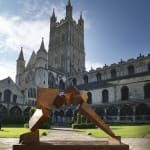Bruce Beasley American, b. 1939
Breakout II, 1992
Bronze
145 x 229 x 61 cm
57 1/8 x 90 1/8 x 24 1/8 in
Including base: 272 x 230 x 72 cm
57 1/8 x 90 1/8 x 24 1/8 in
Including base: 272 x 230 x 72 cm
Edition 1 of 9
'Breakout II' is a large outdoor work that perfectly captures the spirit of Bruce Beasleys works of the 1990s. Skillfully poised with a beautiful painterly patina this work like much...
'Breakout II' is a large outdoor work that perfectly captures the spirit of Bruce Beasleys works of the 1990s. Skillfully poised with a beautiful painterly patina this work like much of Beasleys is profoundly and proudly visual. Rather than resembling any one thing, his works evoke many things. In particular Beasley's outdoor works immerse the viewer in an experience of form that triggers feelings and sensations.
Today, Beasley is recognized as one of the most noteworthy and innovative sculptors on the American West Coast. He discovered his natural affinity with metal at an early age and won a prize in a national metalworking contest aged 15. His first bronze casts were executed at Dartmouth College before he transferred to the University of California, Berkeley art department in 1959, a time at which Berkeley was seen to be the epicentre of a sculptural revival. He then joined Peter Voulkos, Harold Paris and foundry-man Donald Haskin to build the Garbanzo Works, a foundry in West Berkeley where they created major works in cast bronze and aluminium.
Born in 1939 in Los Angeles, California, Bruce Beasley honed his metalworking talents while studying at the University of California, Berkley art department. While still a student in the early 1960’s Beasley became the youngest artist ever to be collected by MOMA New York.
Known for his astounding cubic and more recently his complex circular works, Beasley’s sculptures as much explore the simple beauty of shape as they do mass and geometry. Beasley’s inspiration originates predominantly from organic structures and through both observation and investigation he has developed his own unique language that is instantly recognisable. Beasley says:
“Nature arrives at this perfect point between change and stillness, between form that is evolving and form that is complete; nature does this most easily and with rare mistakes. Nature remains the ideal guide and the great resource; without it, there is no warmth, no heart and I insist that my work have both.”
Beasley’s intersecting of geometric forms and sometimes apparent defiance of gravity is partly due to his talented use of a 3D computer software system which he helped formulate. This tool for digitally arranging designs and shapes helps the artist to realise what often originally seems an impossibility. This unique way of sketching designs combined with the Beasley’s great technical skill as a metal worker gives his work an emotive movement and life.
Bruce Beasley's work resides within a number of private and public museum collections worldwide. In 2005 the Oakland Museum of California honoured Beasley with a 45 year retrospective exhibition and publication, cementing his place as one of America’s leading sculptors.
Today, Beasley is recognized as one of the most noteworthy and innovative sculptors on the American West Coast. He discovered his natural affinity with metal at an early age and won a prize in a national metalworking contest aged 15. His first bronze casts were executed at Dartmouth College before he transferred to the University of California, Berkeley art department in 1959, a time at which Berkeley was seen to be the epicentre of a sculptural revival. He then joined Peter Voulkos, Harold Paris and foundry-man Donald Haskin to build the Garbanzo Works, a foundry in West Berkeley where they created major works in cast bronze and aluminium.
Born in 1939 in Los Angeles, California, Bruce Beasley honed his metalworking talents while studying at the University of California, Berkley art department. While still a student in the early 1960’s Beasley became the youngest artist ever to be collected by MOMA New York.
Known for his astounding cubic and more recently his complex circular works, Beasley’s sculptures as much explore the simple beauty of shape as they do mass and geometry. Beasley’s inspiration originates predominantly from organic structures and through both observation and investigation he has developed his own unique language that is instantly recognisable. Beasley says:
“Nature arrives at this perfect point between change and stillness, between form that is evolving and form that is complete; nature does this most easily and with rare mistakes. Nature remains the ideal guide and the great resource; without it, there is no warmth, no heart and I insist that my work have both.”
Beasley’s intersecting of geometric forms and sometimes apparent defiance of gravity is partly due to his talented use of a 3D computer software system which he helped formulate. This tool for digitally arranging designs and shapes helps the artist to realise what often originally seems an impossibility. This unique way of sketching designs combined with the Beasley’s great technical skill as a metal worker gives his work an emotive movement and life.
Bruce Beasley's work resides within a number of private and public museum collections worldwide. In 2005 the Oakland Museum of California honoured Beasley with a 45 year retrospective exhibition and publication, cementing his place as one of America’s leading sculptors.
Provenance
From the artistExhibitions
Masterpiece 2018, PL; Sculpture in the City, 2016, London; Crucible II at Gloucester Cathedral, 2014, Gallery Pangolin; Bruce Beasley, Pangolin London, 2012Literature
Bruce Beasley, Pangolin London, 2012, p.45Publications
Crucible II at Gloucester Cathedral, 2014, Gallery Pangolin, p.21Join our mailing list
* denotes required fields
We will process the personal data you have supplied in accordance with our privacy policy (available on request). You can unsubscribe or change your preferences at any time by clicking the link in our emails.



